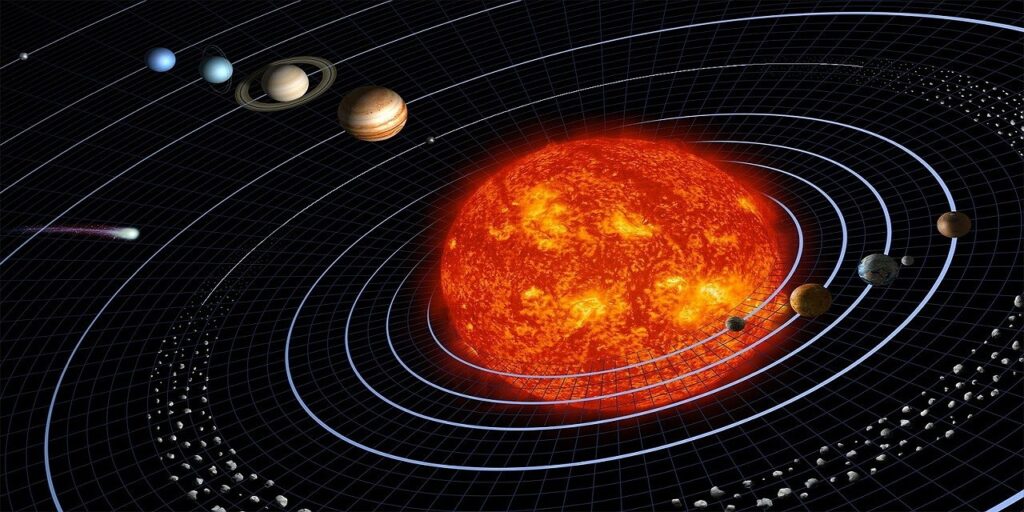The solar system is a planetary system that is made up of stars, planets, and other small bodies. All these are bounded by the gravitational force. Our planetary system named Solar System is located in an outer spiral arm of our Milky Way galaxy. The solar system is vast (although negligible compared to the entire universe) with a huge gap between the planets. In the space gap between the planets, there are comets, asteroids, frozen objects (including some dwarf planets) that yet to be discovered. Within our solar system, there is a star, the Sun, which bounds out all the objects in the system that includes the planets Mercury, Venus, Earth, Mars, Jupiter, Saturn, Uranus and Neptune, moons, asteroids, comets, and meteoroids. Our solar system is known to be one of the most stable systems.
Outside our solar system, scientists have discovered thousands of planetary systems orbiting their host star. Our planetary system is named a solar system because the name of our host star is “Sun” which is derived from the Latin word “solis” and anything that is related to the sun we term it as solar.

How solar system was formed?
Most astronomers believe that our planetary system that is the solar system is formed and evolved as the solar nebula. The solar nebula is a rotating, flattened disk of dust and gases which triggered the formation of the solar system. The solar system formed about 4.5 billion years ago from a dense cloud of gas and dust situated between the stars. The event of a nearby supernova is believed to have caused the cloud to collapse and this has formed our solar system by creating a system that compromised of spinning, swirling disk-like structure.
The role of gravity is crucial in the stability of the solar system. It pulled more and more materials at the center and the intense pressure in the core was enough to begin to combine hydrogen atoms to form helium and releasing a tremendous amount of energy. This led to the formation of our host star the Sun by accumulating 99% of all available matter. In some cases where the planets did not form, the leftover pieces became asteroids, comets, meteoroids, and small, irregular moons.
The large objects that were capable to come under the influence of the sun’s gravity and obey the law of centripetal force were the planets and moons and they form the stabilized solar system. Other dwarf objects that do not come into the influence of any gravitational forces starting floating in space.

Members of the solar system
The members of the solar system include the host star, the Sun, 8 planets, 5 dwarf planets, 200 plus moons, 10,64,044 asteroids, 3,714 comets, and other floating celestial bodies.
What is a planet?
The most recent definition of a planet was adopted in 2006 by the International Astronomical Union. According to it, a celestial body is said to be a planet if it has the following characteristics
- It must orbit the host star.
- It must large enough to possess gravity to form it into a spherical shape.
- It must be large enough that its gravitational force clears away any other similar size object near its orbit around the star.
What is a dwarf planet?
- A dwarf planet is a celestial body that
Orbits the sun - Has sufficient mass and self-gravity to overcome the influence of the rigid body forces
- Has cleared the neighborhood around its orbit
- And is not a satellite

What are Small System Solar bodies?
All other celestial bodies except satellites, orbiting around the Sun are referred to as Small Solar System Bodies.
Moons:
Any heavy objects that orbit the planet are called moons, they are also known as the natural satellite. Our planet earth has one which is 3,84,400 km away from the Earth. There are more than 200 moons in our planetary system. Saturn and Jupiter have the most number of moons and Mercury and Venus do not have moons.
Asteroids, Comets & Meteors:
Asteroids, comets & meteors were formed in billions of numbers in the form of space rocks at the time of the formation of the solar system. According to NASA, there are 10,64,044 known asteroids and 3,714 known comets.

Solar System Facts –
- According to NASA, there are 8 planets, 5 dwarf planets, 200 plus the moon, and 10,63,617 asteroids discovered and identified in our solar system.
- Pluto was declared as the ninth planet in 1930 after its discovery but in 2006 International Astronomical Union (IAU) reclassified Pluto into a dwarf planet because of the discovery of several objects of similar size.
- Our solar system is the only known planet to support life due to its suitable atmospheric conditions and available resources.
Useful Glossary –
- Galaxy – A collection of billions of stars and their planetary system along with gas and dust.
- Solar nebula – A gaseous cloud from which the planets were originated
- Supernova – Explosion of a star at the end of its life
- Centripetal force – A kind of force that keeps an object moving along a circular path
- Celestial body – Heavy objects that are present in space



